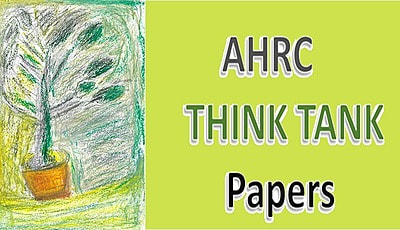Recommendations
Recommendations to the AHRC and partners
These recommendations are given for reflection and future consideration.
Approach and strategies
- Torture as poverty issue: The AHRC’s approach to torture as a poverty issue is highly relevant for other HR interventions. Highlight “torture as a poverty issue” at a wider the South-Asia regional level, with clear examples and best practices.
- Give more emphasis to social, economic and cultural rights,
- Protection: Assist in developing civilian protection mechanisms at country level and at Asia regional level; if possible, establish emergency protection procedures,
- Rule of Law: Special emphasis on addressing pertinent issues like court delays and witness protection,
- Gender: Develop a gender perspective. Integrate a gender perspective in torture prevention, at organisational level and at activity level,
- Legal redress may hinder the process of recovery; all project partners acknowledge this dilemma. The evaluators found that the project partners are very apprehensive not to put pressure on victims to opt for legal redress, and that from a victim’s perspective it may be in his/her interest to opt for a settlement. However it is in the interest of the wider objectives of the project to seek legal redress. Develop a deeper understanding of this dilemma and an institutional position.
- Always ‘put the victim in the centre’. Always get her/his consent and connect to the victim. The team met a woman who did not know that there is an Urgent Appeal about her – Ranjini Rupika, in Janasansadaya. Lost opportunity.
- Healing and therapeutic support need greater attention, programmatic response, and further capacity building.
Coverage
- With the new political situation since May 2009, explore possibilities for covering police torture in the North,
- Identify vulnerable groups and identify special needs,
- Look into the invisibility of torture of children in government schools; file test cases;
- Look into other areas of invisibility of torture (e.g. torture of women).
Strategic Planning, Civil Society Partnership
- The Torture Prevention project would benefit from a clear positioning within the human rights movement in Sri Lanka and civil society at large and a pro-active and inclusive strategy on partnership and alliance building. Including a perspective on the broadest possible civil society platform on torture prevention and human rights and a unified agenda. Create alliances with other organizations with mandates on torture and HR including women’s organizations.
This is a requirement for the project to gain maximum impact. - The AHRC’s contextual analysis should more than before recognize the contribution of other actors in the wider human rights scene.
- Strategic Planning: Organise a joint strategic planning, resulting in a common plan (with time frame and indicators). This should include an analysis of civil society and partnership. Redefine strategic partnership.
- Project structure and management: The project partner network may be revived, possibly in a different form. The future organisational set-up / model needs to be clarified. Clarify common responsibilities while fully maintaining the diverse identities of project partners. Clarify decision-making, coordination structures and communication lines.
- This may require a designated coordination role for one centre or person in SL, (circular, changing every year). The coordinator should a.o. have a clear vision on partnership, be able to navigate between the various pitfalls, and be a problem solver.
Management and Organisational Development
- Results Based Management: in the future project develop a logframe, undertake monitoring of results vis-à-vis expected results in a systematic way, an annual participatory review including review of logframe and if needed refining or revision of qualitative and quantitative indicators. Capacity Building on results based management for the AHRC and partners.
- Develop a Code of Conduct on Torture prevention and rehabilitation including a “Do No Harm” perspective.
- Funding base: diversify the funding base for the project in view of sustainability.
- There is a need for a “change of organisational culture” within the the AHRC-and-partner network, in the sense that “language” and messages of communication should be constructive, inclusive, appreciative, and negative communication should be avoided. A mechanism has to be worked out to bring about a “cultural change”.
- Acknowledge the contributions of RCT as a partner organisation and funder, in publications and in wider communication, where appropriate,
- Develop and institutionalise a notion of “Caring in the organisation”. Caring practices. Identify needs among management, staff, caretakers, victims.
Activities, Best Practices, Tools
- Database: The AHRC has a huge database. It could be used to identify areas needing special attention for most vulnerable groups. Disaggregate case documentation. Include entries on vulnerable groups, gender, types of torture, locations. Identify areas of concern and develop strategies to address these.
- Management of the database: Formalise guidelines on data base management, including on privacy, data base protection, possibly a Code of Conduct for partners,
- Research and studies: Based on its extensive database the AHRC may undertake a deeper and comprehensive study into root causes of torture, redress, coping and healing: determinants/root causes, risk factors, possible prevention and protection strategies.
- Legal redress: case conferences / peer discussions between project partners, especially on exceptional cases. Intervision between human rights lawyers. Intervision on discrimination experienced by female lawyers.
- The shelter homes do not discriminate between torture victims and victims of ‘other’ types of violence. There is a consensus in the humanitarian sector that humanitarian interventions must at any price avoid discrimination between target groups and non-target groups. Do No Harm. It is recommended that RCT, the AHRC and partners develop procedures on how to deal with possible dilemmas resulting from the principle of non-discrimination in view of existing funding requirements.
- Best Practices: Document, analyse and present best practises in a systematic way, including victim’s perspectives.
- Document and analyse lost cases and disappointments, like the case of Lalith,
- Manual: Write a small manual for torture prevention advocacy for grass rootsorganisations in Sri Lanka;
- Write a manual or booklet for organisations working on torture prevention elsewhere in the world, sharing the unique and highly relevant strategies and experience from AHRC and partners. What to do, how to do it. Including case studies, best practices.
- One-page publications: Make one-page leaflets / manuals: a “How to..”, “What to do when…you are arrested”, “What to do when someone in your village is tortured”, etcetera, together with other HR organisations,
- Publications: More attention for target specific publications; avoid overlap; attention for final editing,
- Tools: Use visual materials, visual aides,
- Develop high-quality photo documentation (if possible also video documentation) on the practices of the AHRC and partners; develop expertise in the platform.
- Tools: Partners use a wide variety tools for healing, stress reduction and empowerment – this area could be drastically enhanced by strengthening needs-based healing methods including diversifying tools and methods (incl. body-work, creativity, mindfulness),
- Tools for advocacy and campaigning: Diversify ways to get the message across: involve arts, drama, including visual arts as means of communication; expand partnerships with likeminded organisations and initiatives in the area of culture.
Recommendations to RCT
- RCT has to be given credit for supporting this highly relevant and effective project on Torture Prevention in Sri Lanka. The project has provided new insights in effective models for prevention of torture and rehabilitation of torture victims, in particular in a hostile context. In that sense the project has contributed to RCT’s policy targets for 2015. The evaluation team recommends that RCT continue the support to the AHRC.
- Identify a women’s organisation and/or an organisation working in the North, working on torture rehabilitation,
- RCT’s contribution to partners’ capacity building may focus on:
- Results Based Management,
- Strategic planning and Partnership building,
- Healing and counselling; facilitating professionalisation of rehabilitation care, in particular in the following fields: case supervision, counselling techniques, case conferences, victims’ self-help, groups of para-counsellors, self-help groups for livelihood support,
- Identifying best practices, and support to a publication on the ‘model’ and its best practices. This may be commissioned to someone with an “outsider’s view”.



